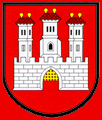

Bratislava is the capital city of the Slovak Republic. It is situated in the south-western part of Slovakia on both banks of the River Danube. It is the seat of the President, the seat of the National Council, and the seat of the Government of the Slovak Republic. Its population is about 450,000 inhabitants. Being the largest Slovak city, it is not only the administrative and industrial, but also the cultural and scientific centre. It is the seat of universieties (such as Comenius University, Slovak University of Technology and University of Economy) as well as the seat of the embassies of the foreign countries.
Bratislava is located near the Austrian, Hungarian and Czech borders. The nearest European metropolises are Vienna (60 km), Budapest (200 km) and Prague (330 km).
| History |
Due to the location of Bratislava in the centre of Europe on the River Danube, this area has been settled since 4000 B.C. The first nations to leave testimony of their life here were the Celtic and the Germanic tribes, then Romans and finally Avars and Slavs.
In the beginning of the 1st century A.D. the area of Bratislava was one of the important fortresses of Limes Romanum protecting Roman Empire against barbarians. The rests of Roman fortress Gerulata are the oldest preserved building in Slovakia.
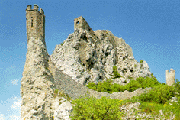 Predecessors of
the present-day inhabitants of Bratislava, the Slavs, came to this region in
the 5th and 6th centuries. The first written mention of Bratislava (907
A.D.) under name Presalauspurch comes from the period of the Great
Moravia - the first state formation of Slavs in this region. Besides
Bratislava, one of centres of the Great Moravia was also Devin on a
hill above the confluence of the rivers Danube and Morava (nowadays the
ruins of a later built Gothic castle stand on this hill and Devin is a part
of Bratislava).
Predecessors of
the present-day inhabitants of Bratislava, the Slavs, came to this region in
the 5th and 6th centuries. The first written mention of Bratislava (907
A.D.) under name Presalauspurch comes from the period of the Great
Moravia - the first state formation of Slavs in this region. Besides
Bratislava, one of centres of the Great Moravia was also Devin on a
hill above the confluence of the rivers Danube and Morava (nowadays the
ruins of a later built Gothic castle stand on this hill and Devin is a part
of Bratislava).
In the Middle Ages Bratislava became after all a part of the Hungarian Empire. As centuries passed, Bratislava had become an imprortant city. In 1291 the city had received the privilege of the free Royal Town from the hands of the king Andrew III. They guaranteed the town its independence, self-government with free election of the Mayor, various tax-reprieves and possibilities of free trade. In 1465, the first university of Slovakia, Academia Istropolitana, was founded here.
 In the period of
the Turkish expansion Bratislava became the coronation town and the seat of
Hungarian Parliament. The city had seen coronations of many Hungarian kings
and queens in the gothic St. Martin's Cathedral (Maria Theresa Habsburg
beeing among them). For few centuries the Bratislava Castle became the royal
seat of Hungarian and later Austro-Hungarian rulers.
In the period of
the Turkish expansion Bratislava became the coronation town and the seat of
Hungarian Parliament. The city had seen coronations of many Hungarian kings
and queens in the gothic St. Martin's Cathedral (Maria Theresa Habsburg
beeing among them). For few centuries the Bratislava Castle became the royal
seat of Hungarian and later Austro-Hungarian rulers.
In the 18th and 19th centuries Bratislava became the centre of Slovak national movement and after desintegration of the Austro-Hungarian monarchy in 1918 Bratislava became the administrative, economical, political and cultural centre of Slovakia within the newly-established Czechoslovak Republic. In 1969 Bratislava became the capital city of Slovakia within Czecho-Slovak Federation and since 1st January 1993, when souvereign Slovak Republic appeared in the map of Europe, Bratislava is its capital city as well.
| Sightseeing |
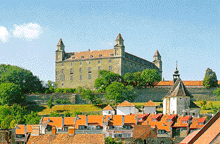 The Bratislava Castle - the dominant of Bratislava over its
historical centre. Its origins lie in the Celtic and Roman period. It was
afterwards re-build in the Gothic style (15th century) and the Renaissance
style (16th century). It acquired its typical four-wing layout in the 15th
century. The present appereance it received in the 17th century. In 1811 it was
destroyed by fire and in 1968 fully reconstructed. In its most powerful
times the Bratislava Castle was the seat of Hungarian and Austro-Hungarian
kings. Today the Bratislava Castle houses the representative halls of the
Slovak National Council, the Slovak Government, and the exhibitions of
Slovak National Museum.
The Bratislava Castle - the dominant of Bratislava over its
historical centre. Its origins lie in the Celtic and Roman period. It was
afterwards re-build in the Gothic style (15th century) and the Renaissance
style (16th century). It acquired its typical four-wing layout in the 15th
century. The present appereance it received in the 17th century. In 1811 it was
destroyed by fire and in 1968 fully reconstructed. In its most powerful
times the Bratislava Castle was the seat of Hungarian and Austro-Hungarian
kings. Today the Bratislava Castle houses the representative halls of the
Slovak National Council, the Slovak Government, and the exhibitions of
Slovak National Museum.
The Devin Castle - the frontier fortress of the Great Moravia standing over the confluence of the Rivers Morava and Danube on the place of an ancient Celtic settlement. It comes from the 9th century. During its history it was in possession of different noble families. In 1809 it was blown up and ruined by Napoleon's troops. After reconstruction and coservation the castle has been open for public.
St. Martin's Cathedral - in 1563-1830 the coronation church of Hungarian kings and queens. It comes from the 14th-15th centuries. It has been build in the Gothic style and in the 18th century re-build in the Baroque style.
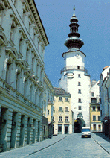 The Michael's Gate in the Michael's Tower - a part of
original city fortifications. It was build in the beginning of 14th century
and it used to be one of the four entrances to the city in the Middle Ages
(the only one preserved). Its name is derived from St. Michael, the
patron saint of St. Michael's Church, once standing next to the gate,
in front of the city fortification. After the Battle at Mohac in 1526
Turks threatened also Bratislava, therefore the city council had pulled the
church down and the stones from it were used to strengthen and extend the
Michael's Gate itself. The Michael's Tower was reconstructed in the Baroque
style in the 18th century. Today the tower houses the Exhibition of Weapons of
the City Museum.
The Michael's Gate in the Michael's Tower - a part of
original city fortifications. It was build in the beginning of 14th century
and it used to be one of the four entrances to the city in the Middle Ages
(the only one preserved). Its name is derived from St. Michael, the
patron saint of St. Michael's Church, once standing next to the gate,
in front of the city fortification. After the Battle at Mohac in 1526
Turks threatened also Bratislava, therefore the city council had pulled the
church down and the stones from it were used to strengthen and extend the
Michael's Gate itself. The Michael's Tower was reconstructed in the Baroque
style in the 18th century. Today the tower houses the Exhibition of Weapons of
the City Museum.
The Franciscan Church - It was built in the end of the 13th century in the Gothic style. It has been thereafter re-built in Baroque and Renessaince styles. It belongs to the oldest sacral buildings in the town. During the coronations of the king it was the place of knighting ceremony when the chosen aristocrats were promoted to the Knights of the Golden Spur. In Middle Ages mayors were elected here and the Hungarian Assembly elected here in 1526 Ferdinand Habsburg for the Hungarian king.
Academia Istropolitana - the first univerisity in Slovakia founded in 1465 by the king Mathew the Corvinus. There were four faculties - the Arts Faculty, the Theological Faculty, the Law Faculty and the Medical Faculty. In present, the original building of Academia Istropolitana is the seat of the Theatre Faculty and the Academy of Arts.
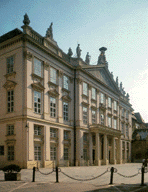 The Primatial Palace - the most outstanding Classicist
palace in the town, built in 18th century as the residence of the Archbishop
of Esztergom. It is situated on the Primatial Square near the Old Town Hall.
The most known and most beautiful is the Mirror Hall of Primatial Palace.
Today the palace serves as the seat of the Mayor of Bratislava as well as
the facility for exhibitions and cultural events.
The Primatial Palace - the most outstanding Classicist
palace in the town, built in 18th century as the residence of the Archbishop
of Esztergom. It is situated on the Primatial Square near the Old Town Hall.
The most known and most beautiful is the Mirror Hall of Primatial Palace.
Today the palace serves as the seat of the Mayor of Bratislava as well as
the facility for exhibitions and cultural events.
The Old Town Hall - one of the oldest stone buildings of Bratislava. It is situated on the Main Square near the Maximilian's (Roland's) Fountain - the oldest fountain in the city (1572). The Old Town Hall was originally the Gothic style house built in the 14th century. Since the 15th century it had been used as the Town Hall. The Old Town Hall houses the Municipal Museum since 1868.
The Grassalkovich Palace - The Rococo style palace with French garden from the 18th century. In present, it is the residence of the President of the Slovak Republic.
| Other Information Sources |
 |
The Office of Lord-Mayor of Bratislava (more photos of Bratislava available here) |
| Bratislava-Down Town | |
| Bratislava Information Service |